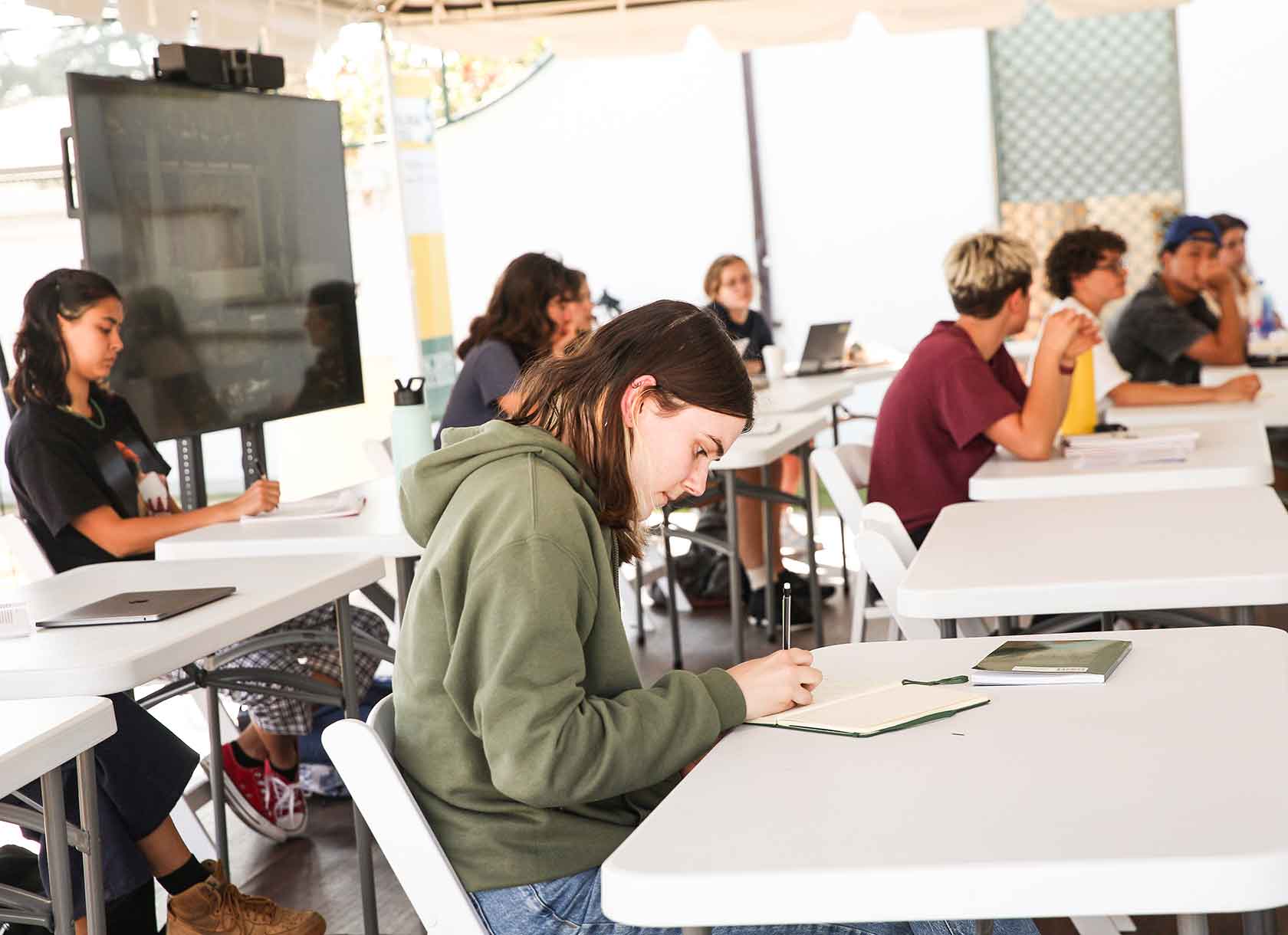By Lauren Mar ’25

Scripps’ nine new outdoor classrooms are a staple of the adjustments that the College has made to align with Los Angeles County’s COVID-19 protocols and ensure the health and safety of the Scripps community. Arranged on Alumnae Field and Jaqua Quad and equipped with monitors, fans, Wi-Fi, floors, and tented ceilings, each outdoor classroom balances community safety priorities with engaged, in-person instruction.
Scripps first planned to implement outdoor classrooms in spring 2020, in preparation for a possible return to campus. The 60 class sessions successfully taught outdoors are the result of much long-term deliberation and effort.
An interdepartmental group effort
According to Lesley Swick, director of facilities operations and sustainability, the planning process was divided into two phases.
“The first phase heavily involved facilities, IT, and AV in figuring out the technical minutiae of the classrooms: What size tents do we use? What kind of screens have the least amount of glare? How do we prevent sound from carrying over to other classrooms?” says Swick. “The second phase brought in faculty to get their perspective.”
Dean of Faculty Jennifer Armstrong helped collect this perspective from the start of the project.
“We surveyed faculty to get a sense of how many of them would be interested in teaching outdoors,” says Armstrong. “Based on those surveys, we decided on the nine classrooms we currently have to meet their needs.”
These instructors were provided with indoor classrooms as a back-up in case of any weather or circumstantial disruptions. Faculty were also trained in the accessible technology used in the canopies, with each classroom equipped with a white board camera to capture a timeline of the course, two 75-inch monitors, high quality cameras, speakers, and microphones. The technology allows the seamless integration of students or invited speakers who may attend remotely.
In addition to faculty, Scripps was cognizant of how the classrooms would affect staff. “Every square foot of space we add to campus impacts 30 to 40 people in terms of how they manage that space. We’ve really tried to include everyone’s perspective because these classrooms have an impact on everyone,” says Swick.
The biggest challenge, though, was the changing nature of COVID-19 protocols. Swick describes the planning process as a “moving target on shifting sands.”
“A lot of it was looking at trends and trying to predict where the guidelines were going,” she says. “We mostly played the ‘worst scenario’ game in order to provide the safest and most academically supportive environment while complying with COVID-19 guidelines to ensure faculty felt safe teaching.”
Positive impact on Scripps’ faculty and students
These efforts have paid off. According to Swick and Armstrong, Scripps’ outdoor classrooms have received overwhelmingly positive reactions from students and faculty.
“I definitely prefer the outdoor classrooms to being online,” says Angela Zhou ’25, who is attending her anthropology course outside. “It’s so much easier to connect with my professor and other students—and because my class is discussion based, it’s much easier to actively participate.”
The outdoor classrooms also support Scripps’ sustainability efforts by drawing less power than traditional classrooms, using technology that can be repurposed indoors in the future. While the College does not intend to keep the canopies post-pandemic, there are plans to integrate more outdoor academic spaces in future designs.
Swick, Armstrong, and Zhou all agree that while the outdoor classrooms have faced some challenges—namely overhead planes heard from nearby Cable Airport—they’re largely a success made possible by Scripps faculty and staff.
“We received enormous support from IT, AV, faculty, and the grounds, custodial, and maintenance teams,” says Swick. “It was a beautiful collaboration.”
“This is the biggest effort that I’ve been involved in as an associate dean, in terms of the length and scope of the project, and the additional aspect that this is something totally new,” Armstrong says. “It was exciting and ambitious, and everybody played a part in this. It was just awesome.”

